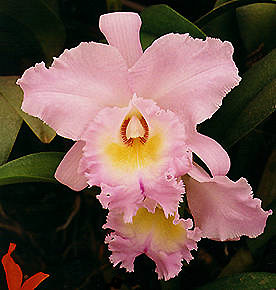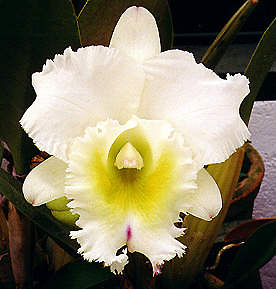

HOW TO TAKE CARE OF YOUR ORCHIDS
by Flávio Cardim

There is no secret to make your orchids to bloom in a wonderful way, there is lack of information how to cultivate them, thatís all. With a few exceptions, they need the maximum of light, good ventilation, watering according to the period of the year and observe, the smaller is the pot, minor must be the interval between the watering. It is important not to mistake intense light with direct sun. Never put your orchids under strong sun-shine but they can stand full sun until 8 oíclock in the morning or after 4h pm. 
I think the mainly recommendations to succeed can be resumed into 5 factors:
1- Light: Give the maximum to Cattleya, Laelia and their hybrids, to Dendrobium, Cymbidium and so on. Plants like Phalaenopsis, Paphiopedilum, Miltonia, Odontoglossum and their hybrids need a reduction of 50% of the light. To provide the shade, use lighter-weight shading material forming a network. You have to be informed about your orchidsí luminosity needs. It is very important to emphasize that the orchids (with the exceptions mentioned) need intense light to have a good blooming. I can guarantee that without this condition, the orchids wonít bloom well. Donít be worry to put your flowered orchid for some days in a place where the light is not so intense but when the flowering finishes, replace it under a suitable light. If you live in a house and you have a tree which leaves retain 40 or 60% of sun rayon, put your orchids beneath and you will have good results.
Note: You have read above that you must not to expose your orchid to full sun but it is rule which is not applicable to every one. A few of them can stand to full sun and grow in your garden provided the increase light is given gradually during the winter in order to make them to be well adapted to the hot period.
2- Ventilation. Maybe it is one of the easiest point. Put your orchids in a well ventilated environment. stuffy places are harmful to the flowers as well to the whole plant.
3- Watering: Containers of different seize must receive different quantity of water. Never forget the bigger is the pot the more it retains water while the smaller ones dry out quicker. This is an important reason for what I donít recommend an automatic watering. In a manual watering, you control the quantity every pot receive.
Another important point, with the proximity of blooming, only the compost must be watering, never water the buds and flowers. If you have many orchids together, detach which blooming or near to bloom. The hanged orchids must be watered more often because they dry out quicker so smaller slabs.
4- Feeding: With the intense luminosity recommended, it is indispensable fertilizer the orchids in order to preventing the foliage to turn brown. There are many kinds of fertilizer but, in my opinion, the best is Ricinusíbran. It is a high nitrogen fertilize and that is why the foliage keep green and healthy.
The application is done 3 times a years in cool weather and 4 em warm or hot weathers. With both, I have been obtaining very good results. In cool weather, avoid to fertilizer during three 3 cooler months. Spread very well over the compost, a tea spoon of fine bran to the smaller pots, a dessert-spoon to the medium and a soap spoon to the bigger.
5- Sanitary: The orchids can be attacked by agents which cause diseases. If fungus appears (black spots on the foliage), bacterial rot, scale insects and mealy bugs, there is a way to finish with them. If you are paying attention to your plants, you will detect the problem in time to control it. For the fungus and bacteriaís problem, there are many efficient available fungicides, just follow the productís instructions and donít water for 24 hours. In other situations use a insecticide. If your plant is infected by virus, the best way to preserve the rest of your collection is to burn it, fortunately those infections are quite rare.
Back to Orchid News




